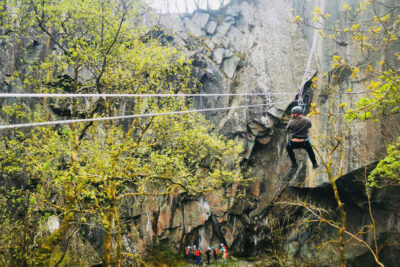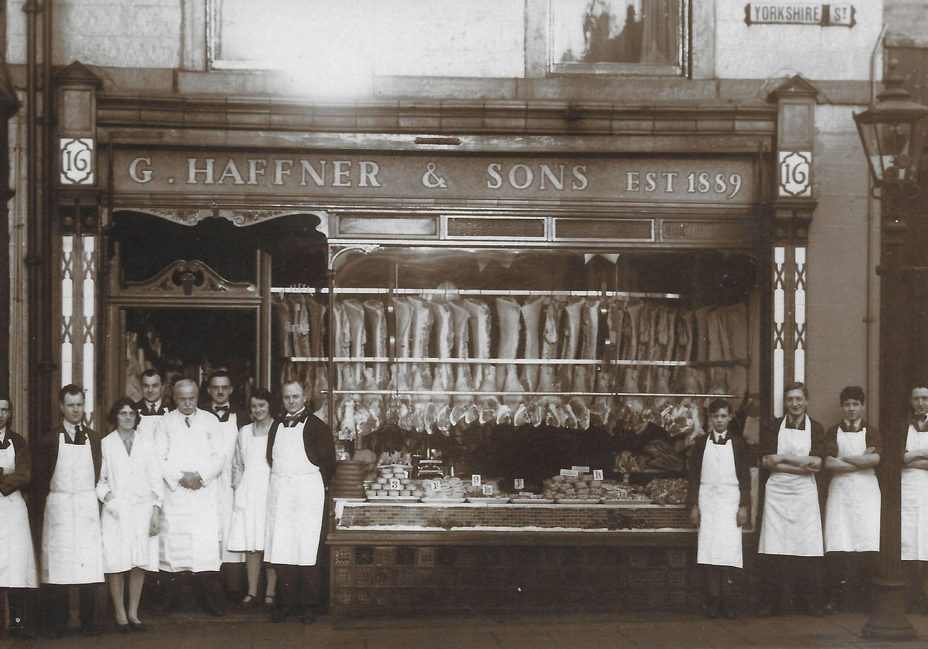
The day drink shamed the town
by Northern Life
When the First World War broke out, George Haffner, a German-born butcher who had been a naturalised British citizen for nearly 20 years, resigned as a member of Burnley Council a year after the war was declared so as to avoid any unpleasantness.
But it did not prevent an alcohol-fuelled crowd from gathering outside his shop in Yorkshire Street and inciting a youth to throw a stone which smashed a window.
One of his daughters, Doris, who was later to marry Billy Edmondson and live in Foxstones, Cliviger, recalled the occasion in notes which she later wrote.
“When we returned from a week’s holiday, the horse-drawn cab from the station stopped well away from the shop. We were terrified to see a large crowd shouting outside the shop. Lena (a sister) let us in, and father was weeping in the kitchen. The police had been called and arrived quickly, but not before a youth had been incited to throw a stone to shatter the window.
“The shop did not close down, and the three brothers – all in the British Army – were allowed home from France on compassionate leave. They put aprons on top of their uniforms and served in the shop.”
Later, it was said that the boys serving in full uniform was a display of support for the British war effort, which shamed the people of Burnley and prevented the animosity from escalating into even more violence.

George Haffner jnr (Raymond’s father) in uniform and carrying the cane, which is now in the Regimental Museum in
Preston
George Haffner told councillors that resigning from the council after 18 months as the representative for Fulledge Ward was “not from any feeling of personal responsibility or lack of ability to carry out the duties of office entrusted to me faithfully, but because I feel that is what the public would very properly expect.”
George had been living in Burnley for 26 years, being sent by his father to help an uncle run a butchers shop in Carlisle when the vines on the family vineyard failed in Germany and the country faced a deep depression.
Learning the butcher’s trade, George moved to Congleton, Cheshire, to open his own shop and married. When that area began to slump, he decided to move again, this time to Lancashire, where the cotton industry was starting to boom. On a train journey, hoping to open a business in Nelson, he was told by a passenger he got talking to that Burnley was the place to be.
His first shop was at 13 Yorkshire Street and later crossed the road to number 16, and eventually moved to Keirby Walk with another shop in the indoor market and Haffner’s Bakery in Marlbrough Street.
George was credited with introducing the sausage to Burnley.
On the day George moved to Burnley, his first son, also named George, was born, to be followed by three brothers – Henry, William, and Albert, all named after English kings, except Albert, who was given the name of Queen Victoria’s consort.
George junior served with the 5th Battalion. The East Lancashire Regiment. In addition to the Military Medal, he was also awarded the Belgian Croix de Guerre in 1918. Three times wounded in action, he called his home in Burnley Road, Cliviger, Krithia, after a battle of the
same name in Gallipoli in which he was injured. The Belgian’s honoured him for his service to the country while his division was based there. He was also wounded in the Somme. He died in 1981 at the age of 92.
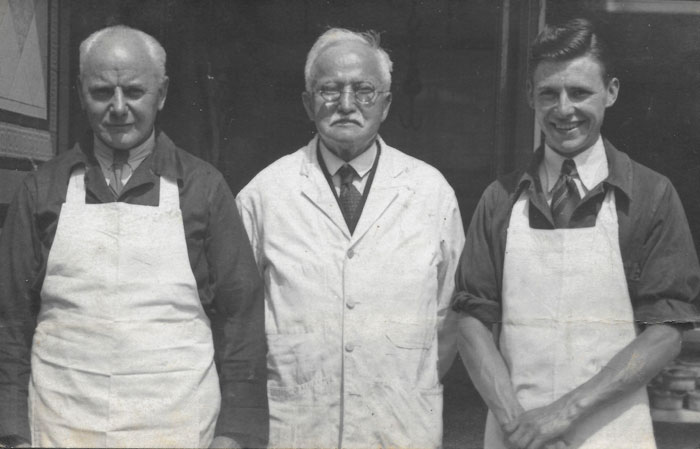
Three Georges: Father, grandfather, and Raymond’s brother, George
His son, Raymond, from Red Lees Road, Cliviger, allowed his father’s uniform and medals to be put on display at the Queen’s Lancashire Regimental Museum, Fulwood Barracks, Preston. The battledress tunic and cane are part of the World War 1 display.
“I am extremely proud of what my father and his brothers did in the war,” Raymond pointed out. “I always think that the incident when people gathered to demonstrate outside my grandfather’s shop shamed the town. The fact that my brothers went behind the counter in uniform and my grandfather’s time as a councillor should have helped avoid that kind of ignorance.”
George’s brother. William was twice awarded the Military Medal for mending telegraph wires under shell fire. When he was invalided out of the army, he lived in the Co-op Buildings, in Cliviger, and then in Southward Bottom, using a horse-drawn cart to deliver fresh fish around the village. He died in 1957.
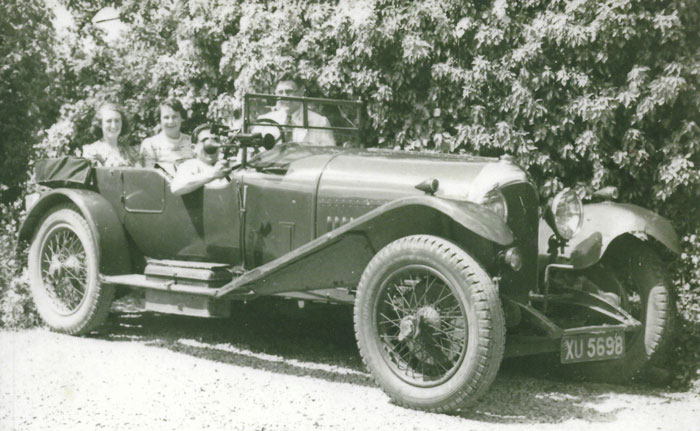
Maurice at the wheel of his Bentley
Raymond, now 90, followed his father into the family business and later passed it over to his son, John.
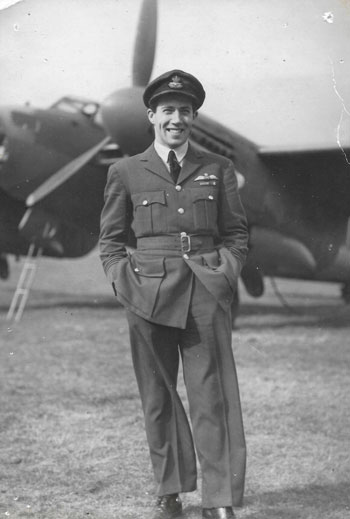
Maurice Briggs and aircraft
Raymond’s wartime memories were again stirred when, on a walking tour of the Lake District, he visited the Anglican Church in Silverdale, where he thought one of his boyhood chums was buried. The family had moved there from Cliviger after the father’s retirement in 1938.
He found not only the grave but a plaque on the wall of the church dedicated to Maurice Briggs. It reminded him of the two brothers who were childhood friends and who both joined the RAF Tragically, both died in peacetime accidents.
Gilbert joined the RAF in 1938 and went to Cranwell. He died in Scotland in 1939 while flying an Avro Anson just days before the war was declared.
The younger brother, Maurice, joined the RAF after the war was declared and was eventually posted to Bomber Command.
He flew De Haviland Mosquitos in the Pathfinder Squadron during the war and was awarded the DFM and later the DFC and bar. He survived many operational tours over Germany – eventually being awarded the DSO – and in 1945, he was posted to Canada as a flying
instructor.
Tragically, as part of the VE Day celebrations in Calgary, he was flying a Mosquito, LR503, known as F for Freddie—an aircraft that had survived 213 operations over occupied Europe.

Raymond, as a boy, his brother George and friend Maurice Briggs
The aircraft streaked over the city at 300 miles an hour, delighting spectators. After a second pass over the airfield, Maurice messaged the control tower that he was about to make a third pass since he had seen a friend arrive.

Raymond
The plane came towards the terminal building, pulling up at the last moment, but hit the anemometer tower and flag pole on top of the control tower. The port wing sheared, and the plane crashed into a field half a mile from the terminal building, struck at a shallow angle and exploded into flames.
Maurice had celebrated his 25th birthday the previous day. “I had a soft spot for Maurice, said Raymond. “He was the Best Man at my brother George’s wedding.
“I could not help but feel sad that a man who was possibly the most decorated Burnley pilot in the Second World War and had been on so many missions returning safely should die on a day of celebration.”




